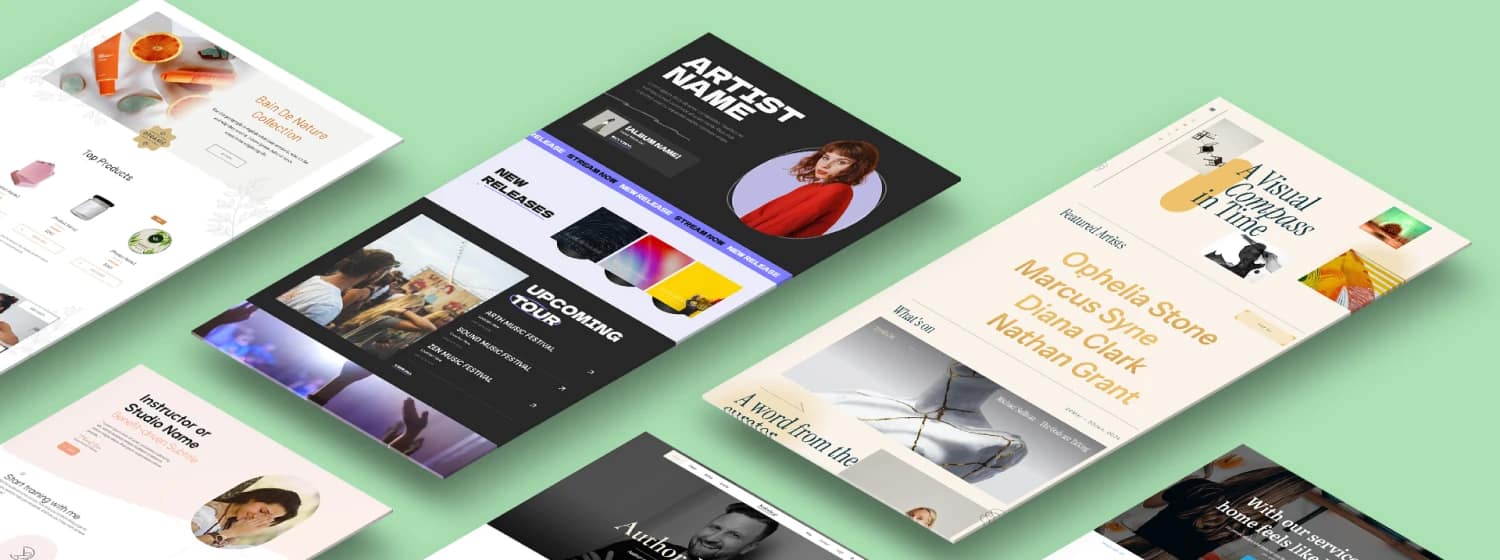TL;DR: What’s the Smartest Way to Use Order Bump Ideas?
An order bump is a small, optional offer placed directly on your checkout page, not after it. Customers can add it with a single click, making it one of the simplest ways to increase your Average Order Value (AOV) by 10–30% without disrupting the buying flow.
To make your bump convert:
✅ Keep it low-cost (typically under 25% of the main product)
✅ Complement the primary offer — don’t distract from it
✅ Place it before payment, near the order summary
✅ Use clear copy, visuals, and a simple checkbox
✅ Offer just one or two max — avoid decision fatigue
In this guide, you'll find the best-performing bump ideas, pricing strategies, placement tips, real examples, and common mistakes to avoid. If you're not using order bumps, you're missing easy revenue from customers who were already ready to buy.
Most small businesses focus on one goal: getting the sale.
But the smarter question is this:
How do you get the most out of a sale while giving your customer even more value than they expected?
It doesn’t have to mean chasing them with endless follow-up emails or hoping they’ll come back later. The best time to earn more is at the exact moment they’re ready to buy – when trust is high and the purchase decision is already made.
That’s why I love a good order bump. I’ve bought my fair share of them — bonus downloads, setup kits, fast-track access. If it’s relevant, low-effort, and clearly valuable, I’m in. And so are your customers.
Order bumps show up on the checkout page, just before payment. They’re easy to add with a single click, low in cost, and designed to enhance the main product — not compete with it.
Used well, they increase Average Order Value (AOV), improve the purchase experience, and help you earn more from the sales you’re already making.
This guide walks you through exactly how to use them.
7 Burning Questions (and Direct Answers) About Order Bumps
These are the top search-driven questions about order bumps — and the ones we’ll answer directly in this guide. Whether you're optimizing your ecommerce funnel, increasing your Average Order Value (AOV), or exploring new checkout page strategies, this section gives you the clarity you need to move forward.
An order bump is a small, optional add-on that appears on the checkout page, just before a customer completes their transaction. It’s designed to be added with a single click — no extra forms, no redirects — and typically features a low-cost, high-relevance offer. Done well, it increases cart value without adding friction to the purchase flow.
These tactics serve different roles in a sales funnel:
- Order bumps are shown pre-purchase, usually on the payment page, and are meant to enhance the current order.
- Upsells come post-purchase and encourage buyers to upgrade or access a higher-tier product.
- Cross-sells appear at various touchpoints and suggest related products or add-ons.
Understanding these distinctions helps you optimize funnel performance and match your offers to the right buyer mindset.
Effective order bump ideas are complementary products that make the main purchase more useful, enjoyable, or complete. Examples include:
* Digital downloads (e.g. templates, checklists, bonus PDFs)
* Product accessories (e.g. care kits, protective add-ons)
* Fast-track services (e.g. express delivery, setup help)
* Mini upsells (e.g. a trial of a higher-tier product)
Think low-risk, high-value, and always relevant to the main item in the cart.
The sweet spot for order bump pricing is 10–25% of the main product's price. For high-ticket items, keep it under 10%. The goal is to trigger an impulse buy without causing hesitation. Use psychological pricing (e.g. $9.95 instead of $10), and consider bundling or discounted add-ons to increase perceived value.
The best-performing order bump placements are:
* Directly below the order summary
* Just above the payment button
* As a checkbox or toggle, clearly integrated into the checkout layout
This keeps the offer visible at the exact moment the buyer is reviewing their cart — without interrupting the conversion flow.
If you’re building your store or funnel with WordPress, you’ve got powerful options for adding high-converting one-click order bumps to your WooCommerce or digital product checkout experience. Here are some of the best tools and plugins:
* CartFlows – A robust sales funnel builder for WooCommerce with built-in order bump support, optimized checkout layouts, and upsell/downsell flows.
* FunnelKit(formerly WooFunnels) – A full-featured funnel platform that integrates seamlessly with WooCommerce. It offers true one-click order bumps, A/B testing, and performance tracking.
* Thrive Suite – Use Thrive Architect to design your checkout experience visually. While ThriveCart is a separate tool, it integrates well with WordPress and supports order bumps natively.
* One Click Upsell (OCU) by FunnelKit – Adds pre-purchase order bumps and post-purchase upsells directly to WooCommerce checkouts with minimal setup.
* Easy Digital Downloads (EDD) – Ideal for selling digital products on WordPress. The EDD Checkout Add-ons extension lets you offer simple order bumps for eBooks, templates, PDFs, and more.
* UpsellWP – A lightweight plugin that works with WooCommerce to create bump offers, upsells, and cross-sells, without bloating your checkout process.
Whether you’re selling physical goods, digital downloads, or memberships, these plugins help you implement conversion-optimized order bumps right inside WordPress — no external platforms required.
Great order bump examples include:
* A digital planner bundle added to an online course
* A shoe cleaning kit with a footwear purchase
* A refill pack with a skincare product
* A bonus video or template pack offered during course checkout
* A trial membership added to a one-time product purchase
These work because they’re relevant, low-cost, and improve the overall customer experience — all without changing the checkout flow.
The Problem: Your Checkout Isn’t Pulling Its Weight
Most small businesses think the hard part is done once someone hits “Buy.” But the truth? That last click is where you either leave money on the table — or quietly multiply it.
The average cart abandonment rate sits at nearly 70%. That’s 7 out of 10 customers walking away after doing everything but paying. And across the US and EU, $260 billion in lost orders are up for grabs — just because most checkouts are built to process, not persuade.
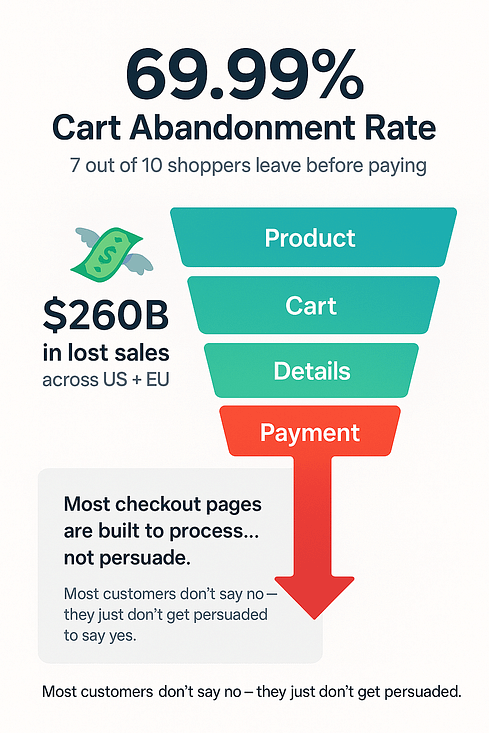
Even worse on mobile where abandonment can hit 85%.
It’s not just about what your checkout includes. It’s about what it could include — and doesn’t.
Let’s talk about what’s going wrong:
- You’ve got a ready buyer… and no follow-up. They’re primed to say yes again — but there’s no additional offer, no added value, no next logical step. Just a form to fill out.
- Most checkouts are passive. Functional, sure. But they’re not doing anything to increase your order value or make the customer feel like they’re getting more than they expected.
- You’re misplacing your moves. An order bump belongs before the purchase — not hidden in a post-sale funnel or lumped into confusing add-ons. Bad timing kills conversions.
- Weak bump offers break trust. If it feels random, overpriced, or disconnected from the main product, it doesn’t help — it hurts.
Friction adds up fast. Clunky layout, too many options, confusing UX — and the buyer starts to second guess. Momentum dies. So does the sale.
Order bumps are your shot to get more out of the sale you’ve already earned – without needing to write another email, launch another retargeting ad, or build a 9-step post-purchase funnel.
But only if your checkout is designed to close the loop.
The Cost of a Quiet Checkout Page
Every “yes” you don’t ask for at checkout is revenue you’ll never see.
- No bump = no bonus revenue. Order bumps can add 10–30% more per sale — without extra traffic or effort. If you’re not offering one, you’re leaving money behind.
- You lose momentum at the most crucial point. The buyer’s already in. Their guard is down. That’s your moment to offer more — not go silent.
- If it feels like a decision, it’s a problem. The best bumps are instinctive. Quick. Effortless. A “sure, why not” — not a speed bump.
A bump makes the purchase feel complete. Done right, it adds value. It rounds out the offer. And your customer walks away feeling even better about buying from you.
7 Proven Types of Order Bumps (With Real Examples)
Not all order bumps are created equal — and the wrong one can do more harm than good.
The best bump offers don’t just add something — they complete something. They make the main product better, faster, easier, or more satisfying. And they do it with minimal friction.
Below are seven proven types of order bumps that consistently convert. Each one is backed by real-world examples, so you can see exactly how to apply them — whether you’re selling digital products, physical goods, services, or memberships.
1. The Practical Pairing
This is the no-brainer. The thing that makes the main product easier to use, set up, or enjoy right away.
Think potting mix with a plant kit. A screen protector with a phone. A brush with your lettering course. It’s practical, obvious — and almost expected.
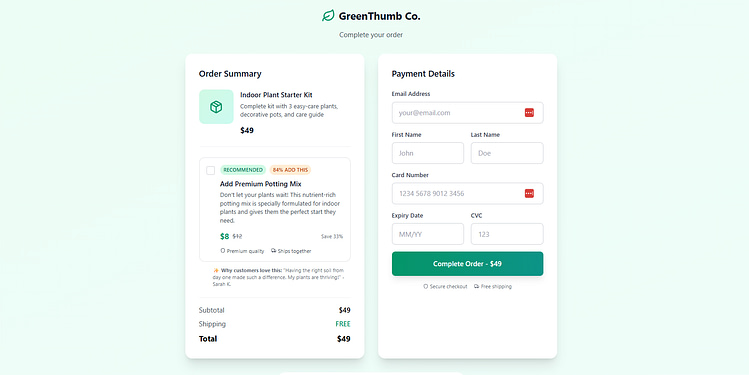
This type of order bump works because it reduces friction after purchase. Your customer doesn’t have to go looking for “the thing that goes with the thing.” You’ve already thought of it for them.
It’s not about squeezing in more revenue — it’s about being helpful. And when the add-on is low-cost and directly useful, it often gets a “yes” without a second thought.
✅ Best for: Physical products, toolkits, starter kits, DIY offers
✅ Price point: Under 20% of the main product
✅ Goal: Increase convenience and eliminate post-purchase hurdles
2. The Digital Download
This one’s all about instant value.
You’re offering something lightweight but useful — a resource your customer can use right away to get more out of the main product. Think: templates to go with a course, an ebook that deepens the topic, or a checklist that speeds up implementation.
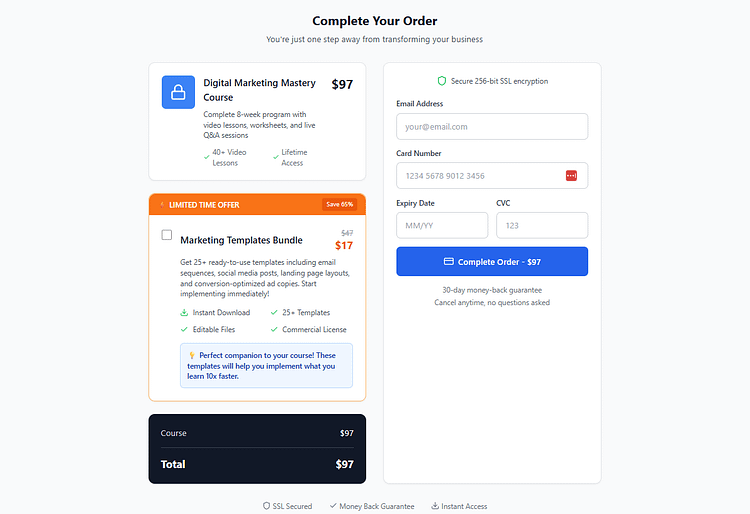
Digital downloads work because they feel high-value with zero shipping or delay. You don’t need to convince someone to “buy more” — you’re giving them a shortcut, a head start, or an extra layer of support.
And since they’re already in the mindset of buying a digital product, clicking “yes, add this” takes zero effort.
✅ Best for: Courses, memberships, info products, coaching
✅ Price point: $5–$19 (or under 25% of cart total)
✅ Goal: Add instant, perceived value without extra complexity
💡 Need ideas for what kind of digital download to offer? Check out our Digital Product Ideas Guide — it’s packed with practical, low-effort offers you can create fast, even if you don’t consider yourself “a product person.”
Whether you’re selling a course, a membership, or a one-time service, this guide will help you come up with bump-friendly offers that feel like a perfect fit (not a last-minute add-on). It’s especially useful if you want to test a few bump ideas without building anything complex. Use it to spark inspiration — and build a bump your customers will actually want to click.
3. The VIP Shortcut
This is for the buyer who wants speed, access, or extra support — and is happy to pay a little more for it.
Think onboarding calls, express setup, or early access to modules. It’s not a new product. It’s an upgrade to the experience.
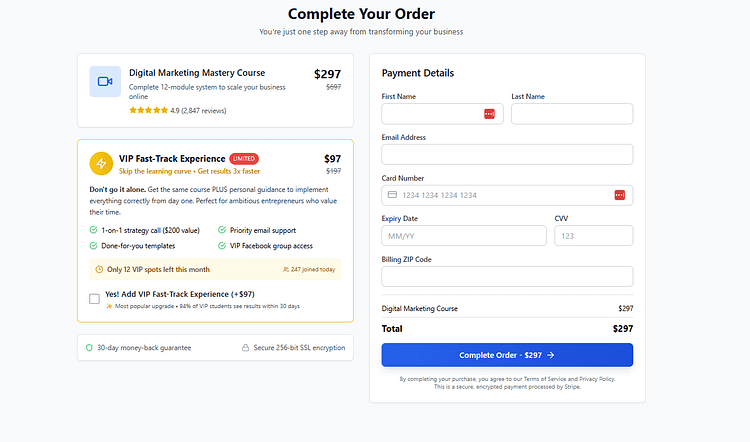
The VIP Shortcut works because it speaks to urgency and ambition. Your buyer already trusts you — now you’re giving them a faster lane, a smoother path, or a more guided hand.
It’s especially effective for service-based offers or premium digital products, where a little extra help goes a long way.
✅ Best for: Courses, coaching, SaaS, services
✅ Price point: $20–$99 depending on perceived value
✅ Goal: Boost AOV while elevating customer experience
4. The “Oops-Proof” Add-On
This one plays defense — and customers love it for that.
You’re offering a little extra peace of mind: a warranty, a cleaning kit, digital file insurance, or even a re-download guarantee. Something that protects their purchase or helps it last longer.
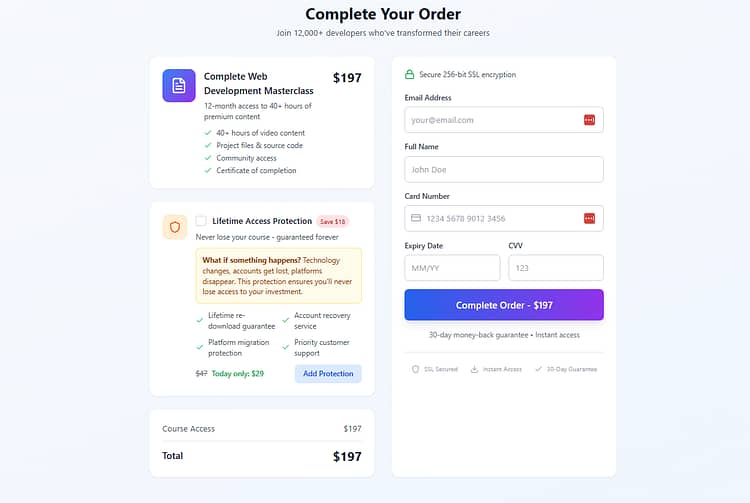
It works because it speaks to a quiet fear — what if something goes wrong? Instead of leaving that unspoken, you offer a simple solution that says, “We’ve thought about that too.”
Even better, it positions you as thoughtful and customer-first — not pushy.
✅ Best for: Physical products, digital goods, tech, subscriptions
✅ Price point: 10–20% of main product
✅ Goal: Reduce buyer hesitation and increase post-purchase satisfaction
5. The “Learn More Later” Offer
This one taps into curiosity — and timing.
Instead of front-loading everything into your main product, you offer a bite-sized upgrade your customer can dive into later: a bonus module, expert Q&A, or short-form mini-course.
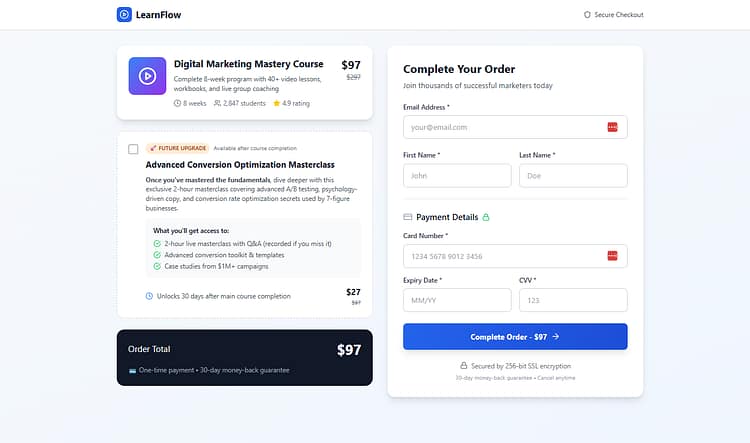
It’s not overwhelming. It’s optional enrichment. And it works beautifully for customers who want to go deeper — just not right this second.
The key is positioning it as a future benefit: “Once you’ve finished this, here’s what comes next.”
✅ Best for: Courses, digital products, workshops
✅ Price point: $9–$49
✅ Goal: Add future value without complicating the initial offer
6. The Emotional Indulgence
Sometimes, your customer doesn’t need the bump… they just want it.
This type of offer is all about delight — a mystery gift, a branded sticker pack, a limited-edition bonus, or even a cheeky novelty item that makes them smile.
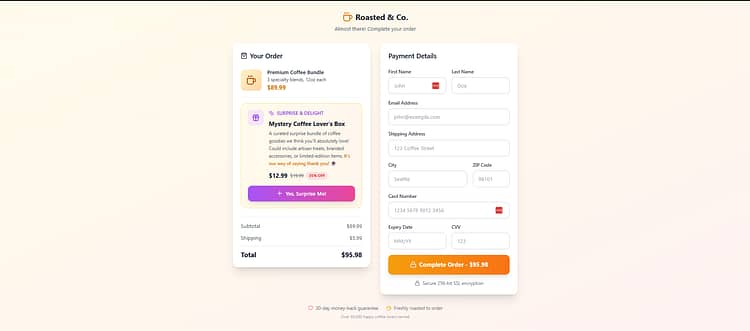
It works because buying is emotional. And when someone’s already excited, adding a small indulgence feels like a reward. It enhances the experience, not the outcome — and that’s powerful.
Done right, this kind of bump deepens brand loyalty and turns a simple purchase into a moment worth remembering.
✅ Best for: Physical products, lifestyle brands, fan-driven communities
✅ Price point: $3–$25
✅ Goal: Surprise and delight while reinforcing brand identity
7. The Social Booster
This bump adds something buyers can’t get from the product alone: other people.
Whether it’s access to a private community, a live Q&A series, or an accountability group, the Social Booster adds value by making the journey feel less lonely — and more supported.
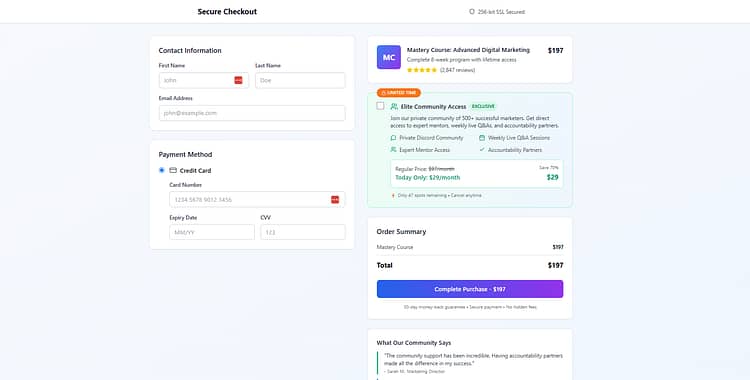
It works because people want to learn, grow, and win with others. A one-time product becomes a shared experience. And when that offer is positioned as exclusive or limited, it often gets a yes on the spot.
It also builds long-term retention. When people connect with others around your product, they’re more likely to stick around and become loyal advocates.
✅ Best for: Courses, memberships, group programs
✅ Price point: $10–$49/month or one-time access fee
✅ Goal: Add community, increase engagement, boost retention
How to Add Order Bumps to Your Funnel Without Killing UX
When it comes to order bumps, *how* you add them matters just as much as *what* you offer. A good bump can lift your revenue — but only if it fits seamlessly into the checkout experience.
Here’s what to keep in mind:
- Placement is everything: The most effective bumps are placed either just above or just below the order summary — or right before the payment field. Test different positions to see where your audience responds best.
- Make it one-click: Order bumps should never require a separate form or redirect. Use a simple checkbox or toggle that adds the offer instantly. The moment you make someone pause or hesitate, you lose the sale.
- Keep it visually clear: Use a thumbnail image (especially for physical products), a concise benefit-driven headline, and a short CTA. It should be scannable, obvious, and easy to say yes to in two seconds or less.
- Resist the urge to pile on: One bump is perfect. Two is your limit. Anything more starts to feel like a pitch, not a service — and that kills trust at the worst possible moment.
- Design for mobile first: Your bump needs to look good and work well on small screens. If it breaks, slows down the page, or feels cramped on mobile, it’s not ready to ship. (styled box end)
Keep the experience smooth, simple, and helpful — and your bump will do exactly what it’s meant to: increase conversions without interrupting the sale.
Keep the experience smooth, simple, and helpful — and your bump will do exactly what it’s meant to: increase conversions without interrupting the sale.
Bump Strategy Optimization – Test It Like You Mean It
A good order bump is never static. You don’t just add it and walk away. You *dial it in* — like you would with any part of your funnel that impacts revenue.
Here’s how to test like you actually mean it:
* A/B test everything Run variations on your price, copy, placement, and urgency. Even small tweaks — like changing “Add This” to “Yes, Upgrade Me” — can shift conversion. (And you can learn how to run a/b tests right here)
* Conversion under 20–30%? It’s likely too expensive, too vague, or too irrelevant. Lower the price or tighten the copy to make the value clearer and the decision easier. (Need more tips on optimizing your funnel conversion rates? Check out this detailed guide)
* Conversion over 70%? Raise the price. Seriously. If everyone’s saying yes, your offer’s likely undervalued — and you’re leaving revenue on the table. (Learn more about pricing mistakes to avoid right here)
* Test bump vs. no bump This isn’t theoretical. Measure your before-and-after AOV to see the real impact. Don’t just assume it’s working — prove it.
* Monitor cart abandonment If bump performance goes up but checkout completion drops, something’s off.
A good bump boosts revenue *without* creating hesitation. Watch the signals. (And learn more about overcoming cart abandonment right here)
Smart bumps aren’t just clever — they’re calibrated. Track, tweak, and test until your bump earns its keep.
FAQ – Order Bump Strategy
Conclusion – Small Button, Big Difference
Order bumps might be the smallest element on your checkout page — but they can make the biggest difference to your bottom line.
They’re quick to build. Easy to test. And they generate more revenue from the customers you’ve already earned — without disrupting their flow or pushing too hard.
The key? Keep it relevant. Keep it simple. Keep it human.
Start with one solid bump. Make it a natural next step for your buyer. Then refine, optimize, and scale.
Want to Add Smart, High-Converting Bump Offers?
Thrive Suite gives you everything you need to build fast-loading, fully optimized checkout pages — complete with one-click bump offers that feel seamless to your customers and drive more revenue for you.
No extra plugins. No expensive funnel tools. Just one platform designed to help digital creators and small businesses sell smarter.
👉 Get Thrive Suite today — and start turning more checkouts into higher-value sales.

